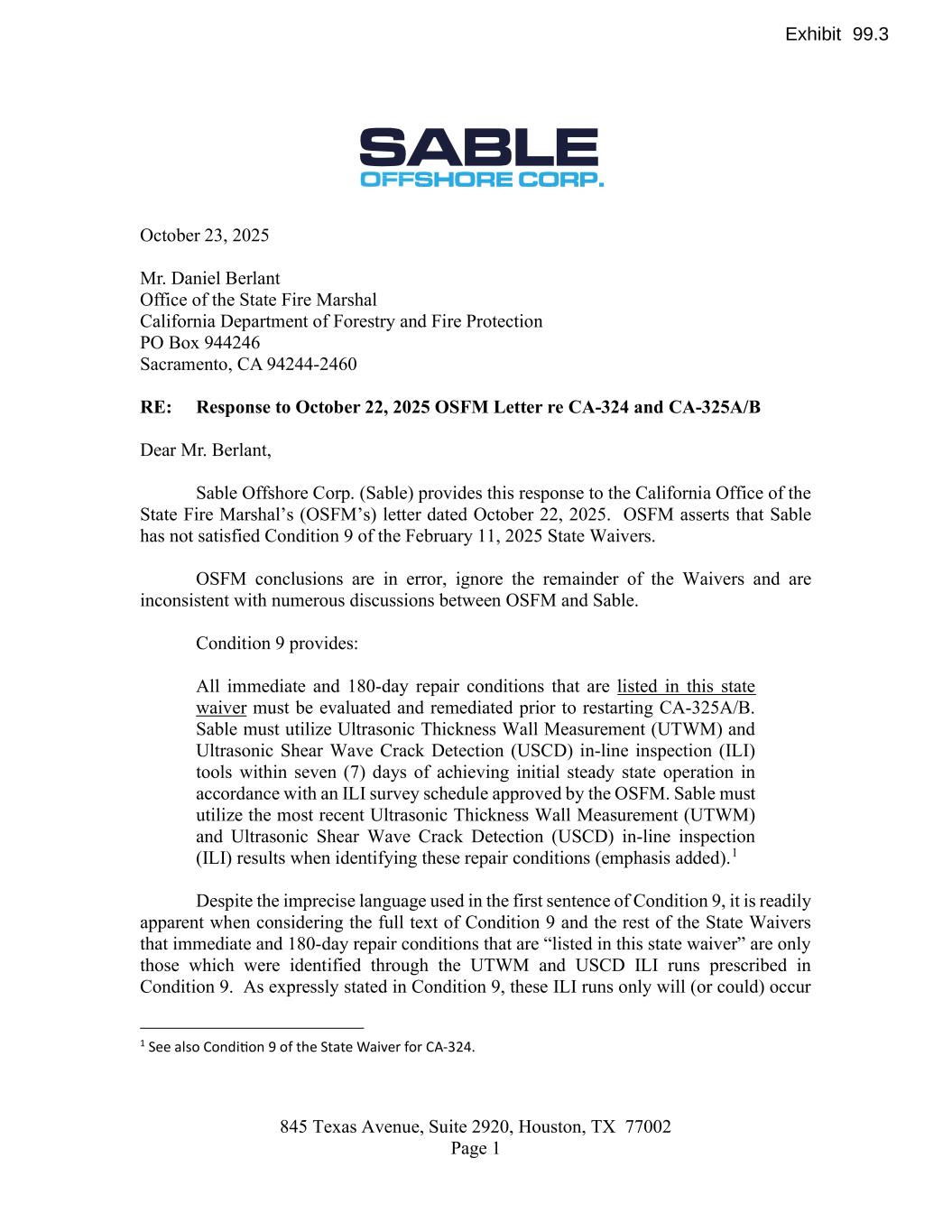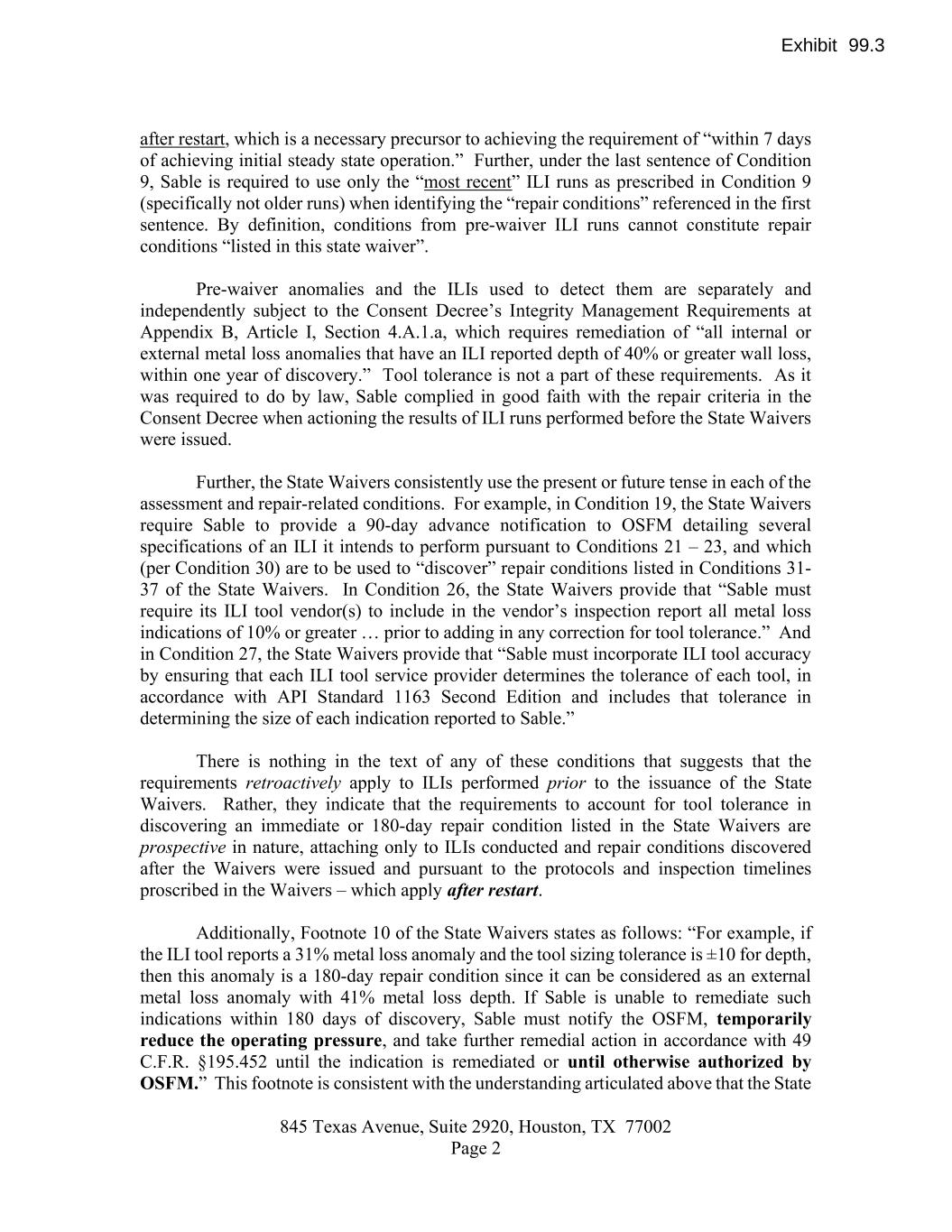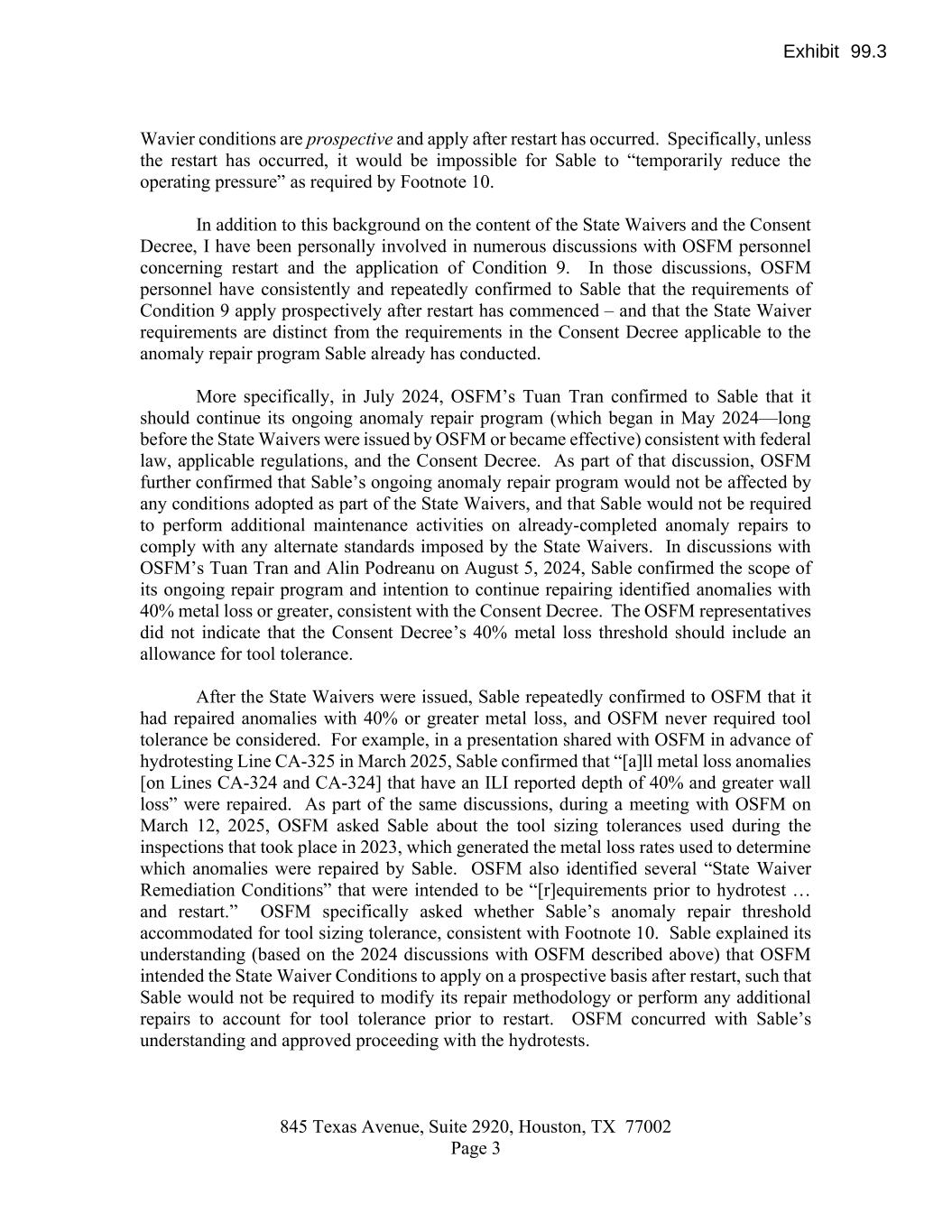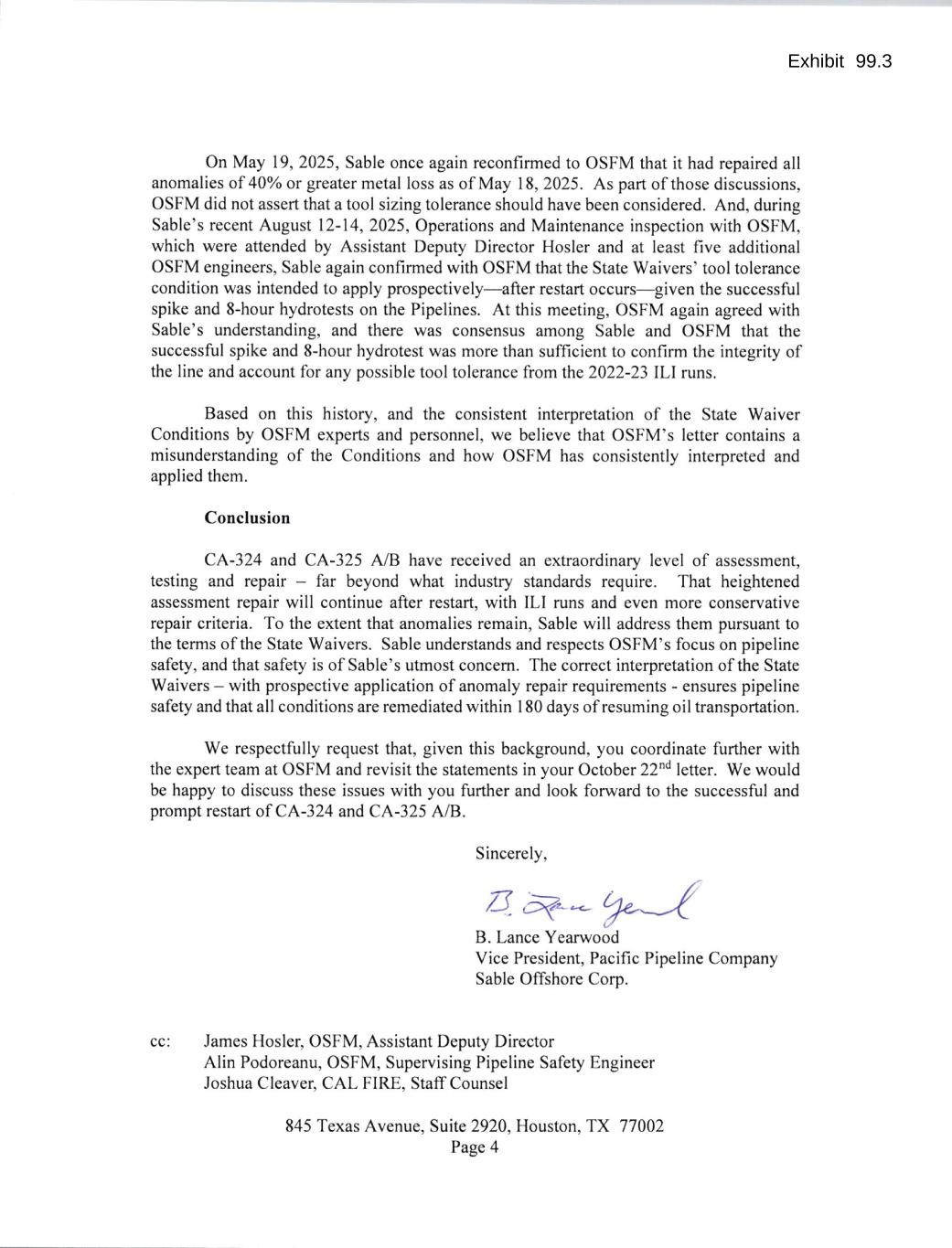
845 Texas Avenue, Suite 2920, Houston, TX 77002 Page 1 October 23, 2025 Mr. Daniel Berlant Office of the State Fire Marshal California Department of Forestry and Fire Protection PO Box 944246 Sacramento, CA 94244-2460 RE: Response to October 22, 2025 OSFM Letter re CA-324 and CA-325A/B Dear Mr. Berlant, Sable Offshore Corp. (Sable) provides this response to the California Office of the State Fire Marshal’s (OSFM’s) letter dated October 22, 2025. OSFM asserts that Sable has not satisfied Condition 9 of the February 11, 2025 State Waivers. OSFM conclusions are in error, ignore the remainder of the Waivers and are inconsistent with numerous discussions between OSFM and Sable. Condition 9 provides: All immediate and 180-day repair conditions that are listed in this state waiver must be evaluated and remediated prior to restarting CA-325A/B. Sable must utilize Ultrasonic Thickness Wall Measurement (UTWM) and Ultrasonic Shear Wave Crack Detection (USCD) in-line inspection (ILI) tools within seven (7) days of achieving initial steady state operation in accordance with an ILI survey schedule approved by the OSFM. Sable must utilize the most recent Ultrasonic Thickness Wall Measurement (UTWM) and Ultrasonic Shear Wave Crack Detection (USCD) in-line inspection (ILI) results when identifying these repair conditions (emphasis added).1 Despite the imprecise language used in the first sentence of Condition 9, it is readily apparent when considering the full text of Condition 9 and the rest of the State Waivers that immediate and 180-day repair conditions that are “listed in this state waiver” are only those which were identified through the UTWM and USCD ILI runs prescribed in Condition 9. As expressly stated in Condition 9, these ILI runs only will (or could) occur 1 See also CondiƟon 9 of the State Waiver for CA-324.

845 Texas Avenue, Suite 2920, Houston, TX 77002 Page 2 after restart, which is a necessary precursor to achieving the requirement of “within 7 days of achieving initial steady state operation.” Further, under the last sentence of Condition 9, Sable is required to use only the “most recent” ILI runs as prescribed in Condition 9 (specifically not older runs) when identifying the “repair conditions” referenced in the first sentence. By definition, conditions from pre-waiver ILI runs cannot constitute repair conditions “listed in this state waiver”. Pre-waiver anomalies and the ILIs used to detect them are separately and independently subject to the Consent Decree’s Integrity Management Requirements at Appendix B, Article I, Section 4.A.1.a, which requires remediation of “all internal or external metal loss anomalies that have an ILI reported depth of 40% or greater wall loss, within one year of discovery.” Tool tolerance is not a part of these requirements. As it was required to do by law, Sable complied in good faith with the repair criteria in the Consent Decree when actioning the results of ILI runs performed before the State Waivers were issued. Further, the State Waivers consistently use the present or future tense in each of the assessment and repair-related conditions. For example, in Condition 19, the State Waivers require Sable to provide a 90-day advance notification to OSFM detailing several specifications of an ILI it intends to perform pursuant to Conditions 21 – 23, and which (per Condition 30) are to be used to “discover” repair conditions listed in Conditions 31- 37 of the State Waivers. In Condition 26, the State Waivers provide that “Sable must require its ILI tool vendor(s) to include in the vendor’s inspection report all metal loss indications of 10% or greater … prior to adding in any correction for tool tolerance.” And in Condition 27, the State Waivers provide that “Sable must incorporate ILI tool accuracy by ensuring that each ILI tool service provider determines the tolerance of each tool, in accordance with API Standard 1163 Second Edition and includes that tolerance in determining the size of each indication reported to Sable.” There is nothing in the text of any of these conditions that suggests that the requirements retroactively apply to ILIs performed prior to the issuance of the State Waivers. Rather, they indicate that the requirements to account for tool tolerance in discovering an immediate or 180-day repair condition listed in the State Waivers are prospective in nature, attaching only to ILIs conducted and repair conditions discovered after the Waivers were issued and pursuant to the protocols and inspection timelines proscribed in the Waivers – which apply after restart. Additionally, Footnote 10 of the State Waivers states as follows: “For example, if the ILI tool reports a 31% metal loss anomaly and the tool sizing tolerance is ±10 for depth, then this anomaly is a 180-day repair condition since it can be considered as an external metal loss anomaly with 41% metal loss depth. If Sable is unable to remediate such indications within 180 days of discovery, Sable must notify the OSFM, temporarily reduce the operating pressure, and take further remedial action in accordance with 49 C.F.R. §195.452 until the indication is remediated or until otherwise authorized by OSFM.” This footnote is consistent with the understanding articulated above that the State

845 Texas Avenue, Suite 2920, Houston, TX 77002 Page 3 Wavier conditions are prospective and apply after restart has occurred. Specifically, unless the restart has occurred, it would be impossible for Sable to “temporarily reduce the operating pressure” as required by Footnote 10. In addition to this background on the content of the State Waivers and the Consent Decree, I have been personally involved in numerous discussions with OSFM personnel concerning restart and the application of Condition 9. In those discussions, OSFM personnel have consistently and repeatedly confirmed to Sable that the requirements of Condition 9 apply prospectively after restart has commenced – and that the State Waiver requirements are distinct from the requirements in the Consent Decree applicable to the anomaly repair program Sable already has conducted. More specifically, in July 2024, OSFM’s Tuan Tran confirmed to Sable that it should continue its ongoing anomaly repair program (which began in May 2024—long before the State Waivers were issued by OSFM or became effective) consistent with federal law, applicable regulations, and the Consent Decree. As part of that discussion, OSFM further confirmed that Sable’s ongoing anomaly repair program would not be affected by any conditions adopted as part of the State Waivers, and that Sable would not be required to perform additional maintenance activities on already-completed anomaly repairs to comply with any alternate standards imposed by the State Waivers. In discussions with OSFM’s Tuan Tran and Alin Podreanu on August 5, 2024, Sable confirmed the scope of its ongoing repair program and intention to continue repairing identified anomalies with 40% metal loss or greater, consistent with the Consent Decree. The OSFM representatives did not indicate that the Consent Decree’s 40% metal loss threshold should include an allowance for tool tolerance. After the State Waivers were issued, Sable repeatedly confirmed to OSFM that it had repaired anomalies with 40% or greater metal loss, and OSFM never required tool tolerance be considered. For example, in a presentation shared with OSFM in advance of hydrotesting Line CA-325 in March 2025, Sable confirmed that “[a]ll metal loss anomalies [on Lines CA-324 and CA-324] that have an ILI reported depth of 40% and greater wall loss” were repaired. As part of the same discussions, during a meeting with OSFM on March 12, 2025, OSFM asked Sable about the tool sizing tolerances used during the inspections that took place in 2023, which generated the metal loss rates used to determine which anomalies were repaired by Sable. OSFM also identified several “State Waiver Remediation Conditions” that were intended to be “[r]equirements prior to hydrotest … and restart.” OSFM specifically asked whether Sable’s anomaly repair threshold accommodated for tool sizing tolerance, consistent with Footnote 10. Sable explained its understanding (based on the 2024 discussions with OSFM described above) that OSFM intended the State Waiver Conditions to apply on a prospective basis after restart, such that Sable would not be required to modify its repair methodology or perform any additional repairs to account for tool tolerance prior to restart. OSFM concurred with Sable’s understanding and approved proceeding with the hydrotests.
